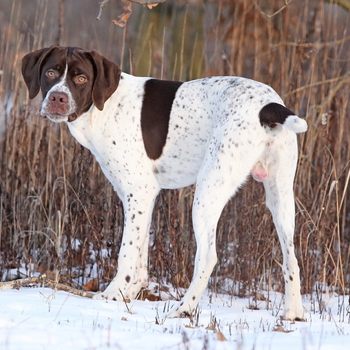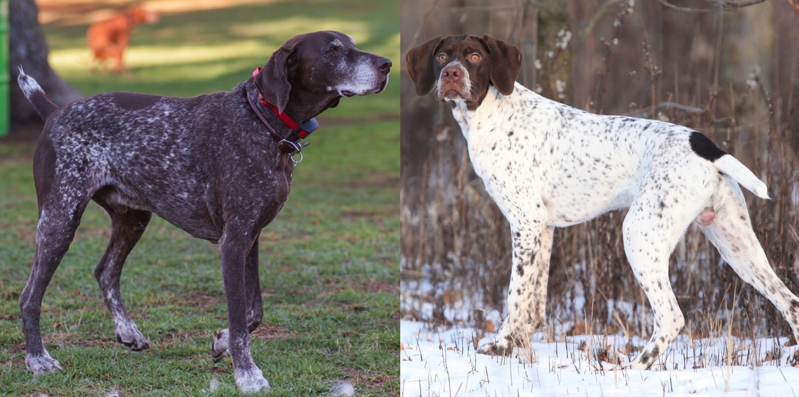Braque Français

The Braque Françaises, or the ‘French Pointers’ consist of the Braque Gascogne and the Braque Pyrénées. The breed was initially split into two in the late 1800s when a search was conducted for the original Braque Français dogs in Southern France, and these two variants were found to exist organically.
A medium-sized Pointer, these dogs are still used today in France for hunting a variety of woodland prey, specifically Woodcock. They have adapted well to living in modern society, and if not used for working, will settle into a family home nicely, provided they have a suitable outlet for their abundant energy.
About & History
While certainly developed in the South of France at a time before records were kept, it is impossible to pinpoint the exact date of origin of the Braque Français. Many claim that they were in existence as far back as the 15th century, though this is difficult to prove.
There are several theories as to who were the original predecessors of this breed. One widely held belief is that the Braque Français is the product of European (Spanish, Portugese and Italian) Pointers and the now extinct ‘Southern Hound’ of Great Britain. In the late 1700s, the Braque Françaises were owned by French nobility, and those that were wealthy enough to keep a large dog at the time. The breed was thus greatly affected by the French Revolution, which saw the higher classes murdered and pillaged. Luckily for the Braque Français, the middle classes were more than willing to own a working dog with such hunting ability, and they weren’t without a place in society for long.
The Braque Françaises were most popular in the south-western region of France, and it was here, that in the 1800s, they were divided into two distinct breeds. A smaller variant was developed to better suit an urban lifestyle and live within the bijou homes of the city. This breed was created by mixing in smaller Pointer and Scenting dogs from the region. This new breed became known as the Braque Français Pyrénées. This, subsequently, became the more common of the two breeds, and remains so to this day. The larger breed became known as the Braque Français Gascogne, as it was most popular in the region of Gascogny.
Mr. Michel Gelinas from Quebec, Canada is thought to be the first importer of the breed to North America in 1976. He brought over a bitch that he called Maffia de l’etang du Marcenac. While this did in fact lead to an increase in popularity of the breed overseas, they remain rare outside of this France to this day.
Though the French word ‘Braque’ may translate to Pointer, the Braque Français is a far more versatile dog than its name may suggest. Used also for tracking, flushing and retrieving of prey, it is evident what an asset this breed has been over the centuries to the French hunters. Likely due to this prized adaptability, the Braque Français was crossed with local hunting dogs, leading to the creation of such breeds as the Braque Saint-Germain and the former French breed of hunting dog, Braque du Puy.
Appearance

Often mistaken for the German Shorthaired pointer, the Braque Français is a medium-sized Pointer type dog with long, lean limbs and large, flat ears. While the Pyrénées and Gascogne are noticeably different in appearance, they do share many similarities. Both breeds will have an elegant head, a relatively short muzzle and soulful eyes that can be any shade from yellow to brown. Their nose should be brown, never black. Their glossy coat is a mix of chestnut brown and white and is often speckled. Large, brown spots in any location on the body are common. Tan markings are acceptable. For the working adult, the tail is often docked on mainland Europe.
The Braque Français Pyrénées is smaller than the Gascogne, and with finer fur, but maintains the same general proportions. The ears of the Pyrénées are not as long, and the lips less pendulous with a narrower muzzle. This dog stands at 47-56cms and will typically weigh between 16 and 25kg.
The larger Gascogne Braque Français will generally stand a good 10cms taller at 58-66cms and will weigh 24-32kg.
Character & Temperament
Sensitive yet sociable, this is a well-balanced dog that gets along well with humans and looks to them for guidance. They thrive in a family setting, though care must be taken to supervise them when around smaller children and pets, particularly if not introduced from a young age, as their natural hunting instincts may prevail.
Their dependence on human companionship is a double-edged sword, as while they make affectionate and loving companions, they can suffer from separation anxiety, particularly if left alone for long periods of time.
In general, the Braque Français is not a natural guard dog, and is unlikely to warn you of any threats – instead being more liable to attempt to make friends with an intruder.
Trainability
Sometimes described as ‘born half trained’, this dog is very good at carrying out the tasks it was designed for and is always obedient. A natural hunting companion, the Braque Français is the ideal choice for bird and game hunters, and requires very little human instruction; instinctively knowing what needs to be done.
Highly intelligent, they tend to be a pleasant dog to train. Many Braque Françaises are sensitive and will require a sympathetic trainer. They respond very poorly to criticisms and harsh commands, and benefit from positive reinforcement and patience when training.
Health
Owing to their natural evolution, and the fact that they are a working breed, the Braque Français tends to be a generally healthy breed, with a lifespan of 12-14 years. While there is a lack of relevant scientific research, it is widely believed that they suffer from few health conditions.
Patellar Luxation
An orthopaedic condition in which the kneecap on one or both hind-limbs will not sit correctly and may dislocate. This will lead to a hopping lameness and pain. In some cases, surgery is corrective.
Patellar Luxation is a described problem, particularly in the North American population. We should always be prudent when breeding such a rare dog, and screening for genetic diseases that are prevalent in similar breeds is a must.
Hip Dysplasia
A common condition affecting the hips of larger dogs. The improperly formed hip joint leads to bone rubbing on bone, the development of osteoarthritis and significant pain and impaired mobility as the dog ages. X-ray screening of the hips of breeding parents is imperative to prevent this condition being passed on.
Elbow Dysplasia
Growth disturbances in the elbow joint result in this group of painful orthopaedic conditions of the forelimb. Clinical examination and imaging (X-rays or CT scanning) can help to diagnose the issue, and depending on the severity, surgery may be indicated.
Aortic Stenosis
This is a condition in which the aortic valve is too narrow, resulting in turbulent and inefficient blood flow from the heart. This is a congenital condition which can lead to heart failure.
Ocular Conditions
Conditions of the eye including Cataracts, Entropion, Ectropion and Progressive Retinal Atrophy should be screened for before breeding as all can negatively impact the vision of the dog.
Exercise and Activity Levels
A dog who relishes an active and outdoor life, the Braque Français will need a minimum of an hour of vigorous exercise daily. A bright breed, they love to be mentally changed, and will enjoy being trained and performing tasks for their master.
They would make a great running partner, and love to be outside in the fresh air with their family. They would highly benefit from access to a large, fenced garden. Failure to adequately exercise and occupy the mind of the Braque Français will likely lead to unwanted and destructive behaviour within the home.
Grooming
With their tight, short and sleek coat, weekly brushing will be more than sufficient. As with any dog, introducing daily tooth brushing and monthly claw clipping from when they are young will help to get them used to these necessary activities, and increase acceptance. With their floppy ears, it is critical to clean them regularly to prevent infections. After swimming and bathing, the ear canals must be thoroughly dried.
Famous Braques Français
Maffia de l’etang du Marcenac was the very first Braque Français to be brought to North America: the Christopher Colombus of the breed, if you will!
Cross-Breeds
No popular cross-breeds of the Braque Français exist.

